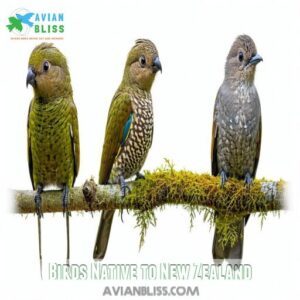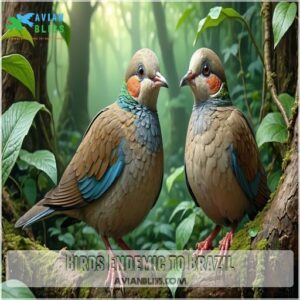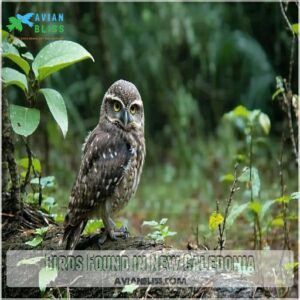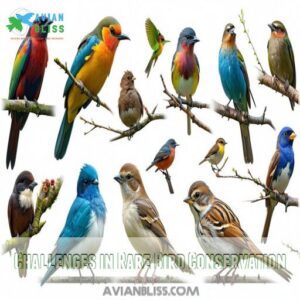This site is supported by our readers. We may earn a commission, at no cost to you, if you purchase through links.
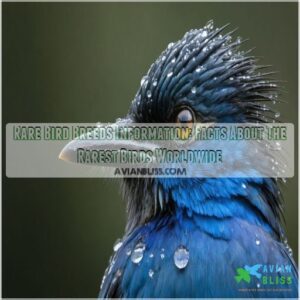
From the critically endangered Blue-eyed Ground-Dove with just 20-30 individuals to the quirky Kakapo – the world’s only flightless parrot – these birds are fighting an uphill battle for survival.
Habitat loss, introduced predators, and climate change are pushing these winged wonders to the brink of extinction.
Each rare bird tells a unique story of adaptation, from the South Philippine Dwarf Kingfisher’s vibrant plumage to the New Caledonian Owlet-Nightjar’s mysterious nighttime habits.
Their survival isn’t just about preservation – it’s a tribute to nature’s incredible resilience.
Table Of Contents
- Key Takeaways
- Rare Bird Breeds Overview
- Characteristics of Rare Birds
- Rare Bird Breeds by Region
- Nocturnal and Flightless Rare Birds
- Rare Birds With Unique Behaviors
- Threats to Rare Bird Populations
- Conservation Strategies for Rare Birds
- Challenges in Rare Bird Conservation
- Supporting Rare Bird Conservation
- Frequently Asked Questions (FAQs)
- What are the rarest birds in the world today?
- Where can I find information about rare birds?
- What makes a bird species rare?
- How many rare birds are there?
- What is the rarest bird in New Caledonia?
- Are rare birds endangered?
- What is the rarest breed of bird?
- What rare bird can’t fly?
- What is the rarest bird to eat?
- What is the hardest bird to find?
- Conclusion
Key Takeaways
- You’ll discover that rare bird species like the Blue-eyed Ground-Dove and Stresemann’s Bristlefront are teetering on the edge of extinction, with populations as low as 20-30 individuals worldwide.
- You’ll learn that habitat loss, introduced predators, and climate change are the most critical threats pushing rare bird breeds toward extinction, with human activities playing a significant role in their declining populations.
- You can make a real difference by supporting conservation efforts, including volunteering at wildlife centers, participating in citizen science programs, and creating bird-friendly habitats in your local environment.
- You can help protect these extraordinary birds by raising awareness, supporting conservation organizations like BirdLife International and the Audubon Society, and understanding the unique adaptations that make each rare bird species crucial to global biodiversity.
Rare Bird Breeds Overview
You’d be amazed at how many bird species are on the verge of disappearing forever.
Each with unique traits that make them fascinating and fragile.
Understanding these rare breeds isn’t just about facts—it’s about grasping why their survival matters to ecosystems and to us.
Critically Endangered Bird Species
If you’re fascinated by nature’s rarest feathered friends, critically endangered bird species paint a sobering picture of global biodiversity loss.
These rare bird breeds, teetering on the brink of extinction, face unprecedented challenges from genetic diversity threats and global extinction risks.
The IUCN Red List reveals shocking population declines, highlighting the urgent need for thorough conservation strategies.
Threatened Birds Due to Habitat Loss
In the shadow of urban expansion, rare bird breeds face a silent crisis of habitat loss.
Deforestation chips away at critical ecosystems, leaving endangered species like the Imperial Amazon and Cebu Flowerpecker with shrinking territories.
Community-driven reforestation strategies and habitat conservation efforts offer hope, empowering local populations to protect these vulnerable bird species from complete extinction.
Birds Affected by Introduced Predators
After battling habitat loss, rare bird breeds face another silent killer: introduced predators.
Cats, rats, and invasive species wreak havoc on island ecosystems, pushing threatened bird species closer to extinction.
From New Zealand’s Kakapo to the Imperial Amazon, these vulnerable populations struggle against non-native hunters that disrupt delicate environmental balances, turning survival into a high-stakes game of hide and seek.
Conservation Efforts for Rare Birds
Against overwhelming odds, rare bird conservation has become a critical mission for protecting our planet’s most vulnerable feathered friends.
Key strategies involve:
- Funding innovative research and protection programs
- Developing legal protections for critical habitats
- Implementing technological monitoring solutions
- Engaging local communities in preservation efforts
- Creating international collaborative networks
These approaches offer hope for preserving endangered bird populations worldwide.
Characteristics of Rare Birds
When exploring rare bird breeds, you’ll discover a world of extraordinary survivors that make these feathered creatures truly remarkable.
Their plumage variations aren’t just about looking pretty – they’re survival strategies that help birds blend into challenging environments. Unique diets and specialized vocalizations set these rare species apart, showcasing nature’s incredible ingenuity.
From microscopic habitats to extreme landscapes, these birds have developed mind-blowing adaptations that push the boundaries of biological survival.
Identifying rare bird breeds requires a keen eye and deep understanding of their distinctive characteristics. Whether it’s camouflage that makes them nearly invisible or hunting techniques that prove being rare isn’t a weakness – it’s a demonstration of their remarkable ability to survive against incredible odds.
Accurate identification also relies on photographic bird evidence, which has become essential in verifying rare sightings.
Rare Bird Breeds by Region
You’re about to explore the fascinating world of rare birds that call unique regions their home, from the lush forests of the Philippines to the remote landscapes of New Zealand.
You’ll discover how geography, habitat, and conservation efforts shape the survival of these incredible avian species.
Each species has its own remarkable story of resilience and adaptation.
Birds Found in The Philippines
Explore the vibrant world of Philippine bird species, where rare avian treasures like the Cebu Flowerpecker and Rufous-headed Hornbill face critical challenges.
With habitat loss threatening their survival, these unique birds showcase remarkable adaptations.
The South Philippine Dwarf Kingfisher, recently rediscovered, symbolizes hope amidst the struggle to preserve the Philippines’ extraordinary bird species diversity.
Birds Native to New Zealand
New Zealand’s rare bird breeds tell a story of survival against the odds. These unique avifauna showcase nature’s resilience in the face of extreme challenges.
Here’s what makes NZ’s flightless birds so fascinating: Kakapo, New Zealand Rock Wren, and other rare species.
- Kakapo: The world’s only flightless parrot with just 250 individuals remaining
- Nocturnal adaptations help these birds dodge predators
- New Zealand Rock Wren survives in challenging alpine environments
- Conservation efforts are critical for these rare bird populations
Birds Endemic to Brazil
Brazil harbors some of the world’s rarest bird species, battling tough conservation challenges in Atlantic forest and Cerrado ecosystems.
The Blue-eyed Ground-Dove, with just 20-30 individuals remaining, symbolizes the fragile biodiversity of Brazilian endemic bird species.
Stresemann’s Bristlefront, critically endangered with only one known individual, highlights the urgent need for targeted conservation efforts.
Birds Found in New Caledonia
From the diverse Brazilian landscape, we shift our focus to New Caledonia’s rare bird breeds.
The New Caledonian Owlet-Nightjar, with fewer than 50 individuals, epitomizes the conservation challenges facing endemic species.
This elusive bird, shrouded in mystery, represents the unique adaptations and fragile existence of rare bird species in this isolated ecosystem.
Birds Native to The Dominican Republic
While New Caledonia’s avian mysteries fade, the Dominican Republic reveals a vibrant story of rare bird survival.
The Imperial Amazon, the nation’s proud national bird, teeters on the brink with just 40-50 mature individuals.
Threatened by habitat loss and Hurricane Maria’s devastation, these shy climbers represent a critical chapter in rare bird conservation, highlighting the fragile balance of bird diversity and survival.
Nocturnal and Flightless Rare Birds
You’ve stumbled upon nature’s most enigmatic avian survivors: nocturnal and flightless rare birds that defy conventional survival strategies.
From the critically endangered Kakapo of New Zealand to other mysterious species, these remarkable creatures challenge everything you thought you knew about bird adaptations.
Characteristics of Nocturnal Birds
As we explore bird regions worldwide, nocturnal birds emerge as masters of darkness.
Their unique sensory adaptations allow extraordinary nighttime hunting strategies, transforming visual limitations into remarkable advantages.
Specialized nocturnal vision enables rare bird breeds to navigate complex environments, avoiding predators through heightened hearing and extraordinary spatial awareness that turns shadows into survival blueprints.
Examples of Flightless Birds
Ever wondered how birds survive without the ability to fly?
Flightless birds demonstrate remarkable adaptations that challenge our understanding of avian survival. These unique creatures have evolved incredible strategies to thrive in challenging environments.
- Kakapo: A nocturnal parrot endemic to New Zealand
- Kiwi: New Zealand’s ground-dwelling national bird
- Penguin: Marine specialists with wing-like flippers
- Ostrich: Africa’s giant ground-dwelling sprinter
- Emu: Australia’s flightless bird
Rare Birds With Unique Behaviors
You’ve stumbled upon a world where birds aren’t just flying creatures but fascinating performers with behaviors that’ll make you look twice.
From the Vogelkop Superb Bird-of-Paradise’s mesmerizing dance to the Rufous-headed Hornbill’s incredible nest-sealing skills,
you’ll discover how these rare avian species challenge everything you thought you knew about bird behavior.
Birds With Exceptional Mating Dances
After exploring flightless nocturnal birds, let’s shimmy into extraordinary mating dances that’ll make your jaw drop.
Some rare bird breeds turn courtship into a jaw-dropping performance art, transforming their plumage and movements into a mesmerizing spectacle of attraction.
Many enthusiasts and researchers also study the role of successful rare bird mating strategies in the survival of these species.
| Bird Species | Dance Characteristic | Unique Feature |
|---|---|---|
| Vogelkop Superb Bird-of-Paradise | Complex choreography | Transforms body shape |
| Sage-Grouse | Elaborate ground display | Inflates air sacs |
| Jackson’s Widowbird | High-jumping ritual | Vertical leap performance |
These avian performers prove that winning a mate isn’t just about looks—it’s about putting on the most spectacular show possible.
Birds With Distinct Diet and Foraging Habits
Just when you thought mating dances were wild, wait until you hear about rare birds’ eating habits.
From frugivorous flowerpeckers munching tropical fruits to nectarivores with precision-tuned beaks, these specialized diets reveal incredible adaptations, often influenced by their bird diets and foraging strategies.
Insectivorous species like the Cebu Flowerpecker showcase nature’s adaptations, proving that in the bird world, what you eat is as unique as how you move. What you eat is as unique as how you move. Specialized diets reveal incredible adaptations. Insectivorous species showcase nature’s adaptations.
Birds With Unique Nesting Behaviors
Nesting prowess reveals the incredible survival strategies of rare bird breeds.
Unique nest behaviors showcase their remarkable adaptations:
- Saliva-sealed entrances
- Mud-reinforced structures
- Cooperative group nesting
- Camouflaged nest sites
- Intricate architectural designs
From the Rufous-headed Hornbill’s ingenious nest-sealing technique to complex cooperative breeding systems, these rare birds demonstrate extraordinary nest architecture that guarantees species survival in challenging habitats.
Threats to Rare Bird Populations
You’re about to uncover the harsh reality facing our planet’s most vulnerable winged friends, where human activities and environmental changes are pushing rare bird species to the brink of extinction.
From habitat destruction to climate shifts, you’ll learn how complex challenges threaten these remarkable creatures.
Their survival depends on urgent, coordinated conservation efforts.
Habitat Loss and Fragmentation
After witnessing unique bird behaviors, you’ll quickly realize habitat loss hammers rare bird populations like a wrecking ball.
Deforestation slashes wildlife spaces, fragmenting ecosystems where endangered birds struggle to survive. These disruptions create isolated pockets that suffocate biodiversity.
| Impact Zone | Habitat Fragmentation Effects |
|---|---|
| Forest Edge | 40% Reduced Breeding Areas |
| Agricultural Lands | 65% Species Migration Barriers |
| Urban Boundaries | 75% Ecosystem Connectivity Loss |
| Mountain Regions | 50% Reduced Nesting Territories |
| Coastal Zones | 55% Migration Path Interruption |
Human activities relentlessly dismantle endangered birds habitats, leaving devastating consequences.
Introduced Predators and Human Activities
In the delicate dance of survival, introduced predators and human activities ruthlessly threaten rare bird populations worldwide.
These invasive challenges push vulnerable species to the brink of extinction through:
- Feral cats hunting native bird populations
- Habitat destruction from urban expansion
- Invasive species disrupting ecological balance
- Human activities fragmenting critical bird territories
Understanding the impact of these predators is essential for effective conservation efforts.
Climate Change and Pollution
Climate change relentlessly hammers rare bird populations, creating a perfect storm of habitat disruption and environmental challenges.
Pollution and shifting ecosystems push species to the brink of extinction. For instance, the invasive species threat is further exacerbated by climate change, as seen in the devastating impact of feral cats, which kill 2.4 billion birds annually.
| Climate Impact | Bird Vulnerability |
|---|---|
| Temperature Rise | Breeding Disruption |
| Habitat Fragmentation | Migration Patterns |
| Extreme Weather | Food Source Collapse |
| Sea Level Changes | Nesting Site Loss |
| Atmospheric Pollution | Respiratory Stress |
Conservation demands immediate, targeted interventions to mitigate these devastating ecological transformations.
Slow Reproduction Rates
While global warming disrupts ecosystems, another silent threat lurks for rare bird breeds: painfully slow reproduction rates.
Some species like the Imperial Amazon produce just one clutch annually, with few chicks surviving.
These breeding challenges create genetic bottlenecks, making conservation a high-stakes chess game where every successful birth matters critically for maintaining population stability and long-term survival.
Conservation Strategies for Rare Birds
You’ll play a key role in saving rare bird species by understanding and implementing targeted conservation strategies.
With careful research, habitat protection, and community involvement, you can help protect these creatures from disappearing forever.
Captive Breeding and Reintroduction Programs
Explore rare bird breeds through captive breeding and reintroduction programs.
These carefully managed efforts boost success rates by maintaining genetic diversity and developing strategic release approaches.
By closely monitoring birds post-release and gaining community support, conservationists breathe new life into vulnerable species, turning the tide for bird populations on the brink of extinction.
Habitat Protection and Restoration
After jumpstarting conservation through captive breeding, protecting rare bird habitats becomes the next critical mission.
Habitat restoration isn’t just about planting trees—it’s about strategic rebuilding of ecosystems.
Here’s how you can help:
- Create bird-friendly corridors connecting fragmented landscapes
- Support funding solutions for rare bird reserves
- Engage local communities in preservation efforts
Your actions can transform devastated landscapes into thriving sanctuaries for endangered avian species.
Research and Monitoring
You’ll want to dive deep into rare bird breeds research by leveraging cutting-edge technological advancements.
Data analysis and population trend monitoring help scientists track avian population dynamics. Genetic diversity studies and habitat mapping provide essential insights into conservation strategies.
Advanced AI tools like ECOGEN can generate synthetic bird sounds, supporting thorough bird conservation research without extensive fieldwork.
Citizen scientists are playing a key role in tracking America’s rarest thrush through initiatives like Mountain BirdWatch Program.
Community Engagement and Education
Building on thorough research, community involvement becomes the heartbeat of rare bird conservation. Supporting initiatives focused on habitat preservation and sustainable responsible ecotourism practices is fundamental.
Spark change through targeted educational efforts that connect people with avian wonders. This can be achieved through various activities, including:
- Attend local birdwatching events
- Join citizen science programs
- Support bird conservation organizations
- Spread awareness through social media
- Participate in local conservation advocacy
Your passion transforms scientific insights into action, bridging the gap between scientific research and grassroots enthusiasm to protect our feathered friends, ultimately turning insights into action and passion into change that supports rare bird conservation and bird conservation organizations.
Challenges in Rare Bird Conservation
When you’re exploring rare bird conservation, you’ll quickly realize it’s a complex challenge that goes beyond simple protection strategies.
You’ll need to understand the intricate balance between habitat preservation, scientific research, and community engagement.
To make a real difference in preserving these extraordinary avian species.
Lack of Information and Research
How do researchers tackle the puzzle of rare bird breeds when critical data remains hidden?
Research priorities for these elusive species are hampered by significant data gaps and funding needs.
Citizen science initiatives, which facilitate large-scale data collection through projects like eBird and bird counts, offer hope, bridging knowledge holes through collaborative efforts.
Understanding rare bird breeds requires creative strategies to overcome information scarcity and prevent potential species extinction.
Human-Bird Conflicts and Perceptions
When limited research meets deeply rooted misconceptions, bird-human conflicts emerge like tangled nests.
Effective bird conflict solutions can mitigate these conflicts.
Cultural perceptions often paint rare bird breeds as nuisances rather than environmental treasures.
Your understanding can shift these views: rare birds aren’t just wildlife, they’re indicators of environmental health.
By transforming assumptions about avian behavior and habitat encroachment, we can transform conflicts into conservation opportunities.
Supporting Rare Bird Conservation
You’ve got the power to make a real difference in protecting the world’s rarest birds, starting right in your own backyard.
By supporting conservation efforts, you’ll help these incredible feathered friends fight against extinction.
simple actions like creating bird-friendly habitats, reducing chemical use, and backing wildlife organizations will make a difference.
Ways to Contribute to Conservation Efforts
Conservation’s heart beats through individual action. Your passion for preserving rare bird breeds can spark meaningful change.
Here’s how you can make a difference:
- Volunteer for local wildlife rehabilitation centers
- Participate in citizen science bird monitoring programs
- Support conservation efforts through targeted donations
- Advocate for sustainable living and habitat protection
Every small step matters in the fight to protect these incredible avian treasures. Individual action makes a difference.
Organizations Involved in Rare Bird Conservation
Ready to champion rare bird conservation? Several powerhouse organizations are leading the charge globally.
| Organization | Focus Area | Impact |
|---|---|---|
| BirdLife International | Global Monitoring | Tracks 13,000+ bird species |
| WWF | Habitat Protection | Preserves critical ecosystems |
| IUCN | Species Assessment | Maintains Red List database |
| WCS | Field Research | Conducts worldwide bird studies |
| Audubon Society | Community Engagement | Mobilizes citizen scientists |
These groups leverage funding models and partnerships to protect our feathered friends’ future. This is important work. Global conservation requires collaborative efforts.
Individual Actions to Help Rare Birds
Jump in and make a difference for rare bird breeds by transforming your backyard into a sanctuary.
Create bird habitats with native plants, install bird-safe windows, and cut back on pesticide use.
Consider implementing bird-friendly products in your daily life to further support conservation efforts.
Support local conservation groups, minimize light pollution, and spread awareness about wildlife.
Every small action counts in protecting these incredible feathered friends.
Frequently Asked Questions (FAQs)
What are the rarest birds in the world today?
You’ll be amazed by the world’s rarest birds!
Stresemann’s Bristlefront has just one known individual, while the Blue-eyed Ground-Dove boasts only 20-30 survivors.
These feathered friends are hanging on by a thread, fighting for survival.
Where can I find information about rare birds?
Imagine a treasure map to rare bird knowledge!
Check ornithological websites, wildlife conservation organizations, local birding clubs, scientific journals, and nature documentaries
to discover fascinating details about Earth’s most elusive winged wonders.
What makes a bird species rare?
Birds become rare when habitat loss, climate change, predation, and low reproduction rates shrink their populations.
Limited genetic diversity, human activities, and environmental challenges push species closer to extinction, making survival increasingly difficult.
How many rare birds are there?
Take the Kakapo, teetering on the brink of extinction with just 250 individuals.
Worldwide, hundreds of bird species face similar challenges, with some populations numbering fewer than 50 individuals, making conservation efforts essential for their survival.
What is the rarest bird in New Caledonia?
You’ll find the New Caledonian Owlet-Nightjar as the rarest bird in the region, with fewer than 50 individuals remaining. Its elusive nature makes it a challenging species to study and conserve.
Are rare birds endangered?
Rare birds face critical threats from habitat loss, introduced predators, and human activities.
Many species teeter on extinction’s edge, with some populations numbering fewer than 50 worldwide.
Conservation efforts are essential for their survival.
What is the rarest breed of bird?
Stresemann’s Bristlefront claims the crown of rarest bird, with just one known individual surviving in Brazil’s vanishing Atlantic Forest, hanging on by a thread in its dwindling habitat.
What rare bird can’t fly?
You might think all birds soar, but the Kakapo proves otherwise!
This nocturnal, flightless parrot from New Zealand is a quirky exception.
It is surviving on conservation lands despite being critically endangered and unable to take wing.
What is the rarest bird to eat?
Consuming extremely rare bird species would be unethical and illegal.
Critically endangered birds like the Imperial Amazon or Kakapo have fewer than 50 individuals remaining, making them scientifically protected against human consumption.
What is the hardest bird to find?
Ever wondered which feathered phantom haunts birders’ dreams? The Scaled Ground-Cuckoo, lurking in Brazil’s Amazon, challenges even seasoned experts with its near-impossible visibility and treacherous habitat.
Conclusion
When push comes to shove, rare bird breeds need your help to survive.
Your awareness can make a huge difference in protecting these incredible species.
By understanding rare bird breeds information and supporting conservation efforts, you’ll play a vital role in preserving Earth’s most vulnerable winged wonders.
Learn, engage, and take action to protect these magnificent creatures from extinction. Your passion can turn the tide for these extraordinary birds.
- http://www.edgeofexistence.org/birds/
- https://www.birdlife.org/worldwide/news/7-projects-led-young-conservationists-are-changing-avian-world
- https://www.usgs.gov/centers/eesc/science/breeding-birds?qt-science_center_objects=0
- https://doi.org/10.1126/science.aaa4984
- https://www.nps.gov/subjects/condors/condorparks.htm




